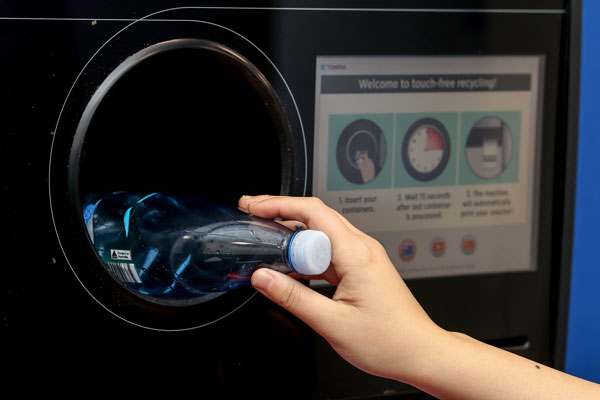Ever wondered what happens to the bottles and cans you return through Return and Earn? Do they get recycled?
Yes, they do – and most of them are recycled right here in Australia!
Your bottles and cans are valued by recyclers because they are separated from other recyclable materials when collected which makes them cleaner and easier to recycle into a new container or other product.
Read on to find out what happens to the three most popular container material types collected.
What happens to aluminium cans?
Aluminium is an amazing material because it is endlessly recyclable and never loses quality along the way.
When you return your aluminium cans through a return point, they are collected and taken to a processing facility in Sydney. The cans are separated from other types of containers, before being crushed and baled into big, colourful cubes.
These are then sold and shipped to aluminium recyclers overseas.
At an aluminium smelter, the cubes of crushed cans are melted down and rolled into sheets of recycled aluminium. These sheets can then be shaped into new products like cans ready to be filled, shipped to your local store and sold where the cycle starts again. This whole process can take as little as 4-8 weeks.
Where are aluminium cans recycled?
As there are currently no aluminium reprocessing facilities in Australia, aluminium cans returned through the scheme are sold to aluminium smelters overseas including the Netherlands and South Korea.
What happens to glass bottles?
All glass bottles deposited at a return point are collected and taken to a sorting facility in Sydney. The bottles are crushed into smaller bits of glass called cullet, and any contamination is removed, including lids and labels.
The cullet is then sent to glass recycling plants to be sorted by colour, before being melted down to form new bottles and jars, using 300 degrees less heat than virgin glass.
From here, the recycled glass bottles are ready to be filled before heading back to your local store, where the cycle begins again.
When you recycle your glass bottles through Return and Earn, they can be back on the supermarket shelf in as little as 30 days!
Where are glass bottles recycled?
All glass bottles returned through the scheme are recycled right here in Australia.
What happens to plastic bottles?
Once deposited at a return point, your plastic bottles are picked up and taken to a sorting facility, where they are baled up before being transported to a purpose-built plastic processing facility in Albury, NSW.
The plastic bottles are sorted, washed and shredded into flakes which is then turned into recycled PET resin, ready to be turned into new beverage bottles and other food-grade packaging.
The new bottles are filled, labelled and back on the shelf in store in as little as six weeks and the cycle begins again.
Where are plastic bottles recycled?
100% of plastic bottles returned through Return and Earn are recycled in NSW, supporting a home-grown circular economy.
What happens to lids?

Where possible, leave the lids on the containers you are returning. They will be recycled too!
When you return your bottles, with lids attached, they are picked up and taken to a sorting centre, before being baled up and transported to a purpose-built plastic recycling facility in Albury, NSW.
Here the bottles and their lids undergo a sink or float sorting process, which helps to separate them from other plastic types. In this process, the plastic bottles have greater density and will sink, while lids, which are made of a lower density, will float to the top.
Once the lids have been separated, they are sent to Astron for recycling in Ingleburn, where they are turned into a variety of items including flower pots and bin lids.
Did you know?
Plastic lids found on drink containers shouldn’t be placed loose in your recycling bin because they are too small for current materials recovery technology to sort on their own (Planet Ark, 2020).